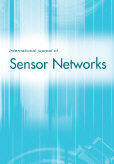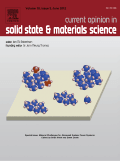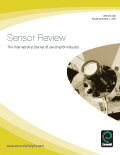
SENSORS AND MATERIALS
Scope & Guideline
Exploring the Synergy of Instrumentation and Materials Engineering
Introduction
Aims and Scopes
- Development of Sensor Technologies:
Research exploring the creation and enhancement of sensor technologies, including novel materials and fabrication methods for improved performance. - Applications in Various Fields:
Studies that demonstrate the application of sensors in diverse fields such as healthcare, environmental monitoring, manufacturing, and smart cities. - Integration of AI and Machine Learning:
Research that investigates the incorporation of artificial intelligence and machine learning algorithms to enhance sensor capabilities and data processing. - Performance Evaluation and Testing:
Papers focusing on the methodologies for testing and evaluating the performance of sensors under various conditions. - Interdisciplinary Approaches:
Research that combines insights from various disciplines (e.g., engineering, materials science, biology) to innovate and advance sensor technology.
Trending and Emerging
- Smart and Wearable Sensors:
There is a significant increase in research focused on smart sensors and wearable technologies, which cater to applications in health monitoring, fitness tracking, and personalized medicine. - Environmental and Ecological Monitoring:
Emerging studies emphasize the use of sensors for environmental monitoring, addressing climate change, pollution detection, and biodiversity conservation. - Integration with IoT and Smart Systems:
A growing trend involves the integration of sensor technologies with Internet of Things (IoT) frameworks, facilitating smart city initiatives and automated systems. - Advanced Data Analytics and Machine Learning:
Research increasingly incorporates advanced data analytics, particularly machine learning techniques, to enhance sensor data interpretation and predictive capabilities. - Sustainable and Eco-friendly Materials:
There is a rising interest in developing sensors made from sustainable and eco-friendly materials, reflecting a global emphasis on sustainability in technology.
Declining or Waning
- Traditional Sensor Materials:
There appears to be a decreasing emphasis on conventional sensor materials, as research increasingly shifts towards novel composites and nanomaterials that offer enhanced sensitivity and specificity. - Basic Sensor Functionality Studies:
Research solely focused on the fundamental principles of sensor operation is waning, as the field moves towards application-driven studies that demonstrate real-world impact and integration. - Static Sensor Applications:
There is a noticeable decline in publications centered around static applications of sensors, with a growing interest in dynamic and adaptive systems that respond to real-time data. - Low-Complexity Sensor Designs:
Research on simple, low-complexity sensor designs has decreased, as the field is trending towards more sophisticated, multifunctional sensors that incorporate advanced technologies.
Similar Journals

Journal of Measurements in Engineering
Bridging Theory and Application in Measurement ScienceJournal of Measurements in Engineering is a pioneering open access journal dedicated to the crucial intersection of engineering and measurement technologies, published by JVE INT LTD in Lithuania. Since its transition to open access in 2018, the journal has significantly contributed to the field by providing a platform for disseminating innovative research findings and advances. With a focus on instrumentation, materials science, and mechanical engineering, it has established itself as a valuable resource for researchers, professionals, and students alike, offering insights that bridge theoretical concepts with practical applications. While currently holding a Q4 ranking in Instrumentation and Q3 ranks in both Materials Science (miscellaneous) and Mechanical Engineering, the journal encourages submissions that challenge existing paradigms and extend the boundaries of conventional measurements. As part of its commitment to fostering open scholarly communication, the journal accepts contributions reflecting a wide range of measurement methodologies and engineering applications up to the year 2024. By engaging with a global audience of practitioners and academics, the Journal of Measurements in Engineering underscores the vitality of precise measurement techniques in advancing engineering disciplines.

Transactions on Electrical and Electronic Materials
Illuminating the Future of Electronic and Optical MaterialsTransactions on Electrical and Electronic Materials, published by Springer, is a distinguished journal aimed at advancing the fields of electrical and electronic engineering, as well as electronic, optical, and magnetic materials. With an ISSN of 1229-7607 and an E-ISSN of 2092-7592, this journal is vital in disseminating impactful research and innovations, providing insights and significant findings that cater to both academia and industry. Holding a Q3 ranking in the categories of Electrical and Electronic Engineering and Electronic, Optical and Magnetic Materials, it serves as a reputable platform for sharing research that influences ongoing developments in these critical areas. The journal's converged years from 2011 to 2024 signify its commitment to providing a comprehensive review of technological advancements. Located in New York City, it appeals to a global audience of researchers, professionals, and students, enhancing their understanding of current trends and practices within the domain.

International Journal of Sensor Networks
Connecting Ideas in Engineering and TechnologyInternational Journal of Sensor Networks, published by INDERSCIENCE ENTERPRISES LTD, is a pivotal resource in the realms of Computer Networks and Communications, Computer Science Applications, Control and Systems Engineering, and Electrical and Electronic Engineering. With an ISSN of 1748-1279, this journal serves as a vital platform for disseminating innovative research and developments related to sensor networks, highlighting groundbreaking work that spans from fundamental sensor technology to sophisticated applications in various engineering fields. The journal, which operates without an open access model, features a convergence of contributions from 2006 to 2024, holding a Q3 ranking across multiple categories as per the 2023 categorization, which reflects its standing and influence within the academic community. Targeted at researchers, professionals, and students, the International Journal of Sensor Networks not only fosters interdisciplinary dialogue but also drives the advancement of technology by publishing quality papers that address contemporary challenges in sensor networks and their applications.

CURRENT OPINION IN SOLID STATE & MATERIALS SCIENCE
Navigating the trends shaping materials science.CURRENT OPINION IN SOLID STATE & MATERIALS SCIENCE, published by Pergamon-Elsevier Science Ltd, is a premier journal in the field of materials science that offers critical insights into the latest advancements and trends in solid-state materials. With an impressive impact factor and a 2023 ranking in the top quartile (Q1) for materials science, this journal provides a platform for researchers, professionals, and students to explore and disseminate high-quality research findings. The journal covers a broad range of topics, encouraging interdisciplinary dialogue among scientists and engineers. While currently not available as open access, its rigorous selection process ensures that only the most impactful and relevant studies are published. Since its inception, CURRENT OPINION IN SOLID STATE & MATERIALS SCIENCE has established itself as an essential resource for anyone involved in the field, facilitating the rapid exchange of knowledge that is vital for advancing material innovations.

Journal of Electronics & Information Technology
Shaping the Future of Electronic EngineeringJournal of Electronics & Information Technology, published by the prestigious Chinese Academy of Sciences, Institute of Electronics, stands as a vital resource in the field of Electrical and Electronic Engineering. With an ISSN of 1009-5896, this journal has been dedicated to the dissemination of advanced research and innovative applications since its inception in 2001. It holds a competitive position within its category, ranked Q3 in the 2023 Scopus database, reflecting its contribution to the scientific community. The journal addresses a wide array of topics related to electronics and information technology, making it indispensable for researchers, professionals, and students aiming to stay at the forefront of technological advancements. Although it operates under a traditional model of access, its cumulative output remains pivotal for knowledge sharing and innovation in the rapidly evolving landscape of electronic engineering. With its commitment to excellence, the Journal of Electronics & Information Technology aims to foster a thriving academic environment and promote impactful research within the discipline.

Sensor Review
Catalyzing Progress in Industrial and Manufacturing EngineeringSensor Review, an esteemed journal within the fields of Electrical and Electronic Engineering as well as Industrial and Manufacturing Engineering, is published by EMERALD GROUP PUBLISHING LTD. With an ISSN of 0260-2288 and an E-ISSN of 1758-6828, this journal has been a crucial resource since its inception in 1981, now extending its coverage to 2024. Although currently classified as Q4 in Electrical and Electronic Engineering and Q3 in Industrial and Manufacturing Engineering for 2023, the journal is recognized for its significant contributions to sensor technology and applications, catering to both theoretical and practical dimensions of the field. Researchers and professionals engaged in sensor innovation and application will find Sensor Review an essential platform for disseminating cutting-edge research and fostering academic dialogue. While it does not offer open access, the journal's rigorous peer-review process and respectability in the academia ensure that published articles meet high scholarly standards. The journal’s impact is further reflected in its Scopus rankings, establishing it as a noteworthy publication among its peers.

Nanotechnology and Precision Engineering
Catalyzing innovation through open access scholarship.Nanotechnology and Precision Engineering is a leading open access journal published by AIP Publishing, dedicated to advancing the fields of nanotechnology and precision engineering. Established in 2006, the journal has become a vital resource for researchers, professionals, and students, reflecting the latest advancements in Electrical and Electronic Engineering, Industrial and Manufacturing Engineering, Instrumentation, Mechanical Engineering, and Nanoscience. With an impressive variety of quartile rankings in Scopus—notably Q1 in several key engineering domains—the journal provides a robust platform for disseminating groundbreaking research. Noteworthy aspects include its open access format introduced in 2018, ensuring that high-quality research is freely accessible to a global audience. By maintaining a commitment to excellence and collaboration, Nanotechnology and Precision Engineering plays a crucial role in shaping the future of technology and innovation.

Optoelectronics Letters
Pioneering Insights in Condensed Matter and Electrical EngineeringOptoelectronics Letters, published by Tianjin University of Technology, is an esteemed platform for the dissemination of innovative research within the fields of atomic and molecular physics, optics, condensed matter physics, and electrical engineering. With its inaugural publication in 2007 and a convergence period extending to 2024, this journal aims to foster scholarly communication and collaboration among researchers and professionals. Although currently lacking an impact factor, it serves a vital niche in the rapidly evolving field of optoelectronics, evidenced by its categorization in the fourth quartile for various physics disciplines and the third quartile in electrical and electronic engineering. Given its ranking dynamics in Scopus, it is an emerging choice for authors seeking to convey their findings on electronic, optical, and magnetic materials. Researchers, students, and industry professionals alike can benefit from its open access options, encouraging a broad dissemination of cutting-edge knowledge that is essential in the advancement of technology and materials science.

Sensors and Actuators Reports
Fostering Global Engagement in Engineering InnovationsSensors and Actuators Reports, published by Elsevier, is a premier open access journal that has been contributing to the fields of physics, computer science, and engineering since its establishment in 2019. With its ISSN 2666-0539, this journal has rapidly gained recognition, achieving Q1 quartile rankings across multiple categories, including Atomic and Molecular Physics, Computer Science, and Electrical Engineering. By providing a platform for high-quality research and innovative findings, Sensors and Actuators Reports is dedicated to advancing knowledge in sensor and actuator technologies, which are pivotal for numerous applications in modern science and industry. The journal's performance is underscored by its impressive Scopus rankings, placing it in the top tiers across various disciplines. Open access ensures that research is widely disseminated, fostering collaboration and enabling researchers, professionals, and students alike to engage with the latest advancements in their fields.

Discover Nano
Igniting Discussions in Nanoscience and BeyondDiscover Nano is a pioneering journal published by SPRINGER, dedicated to the rapidly evolving field of nanoscience and nanotechnology. Established in 2023, this innovative platform provides an open-access forum for researchers, professionals, and students to share and disseminate cutting-edge findings in materials science and condensed matter physics. With its commitment to accessibility, Discover Nano encourages a broad spectrum of contributions, aiming to foster collaboration and stimulate discussion in this dynamic area of study. As a new entry into the academic community, the journal holds great potential for growth, aspiring to increase its visibility and impact in the materials science arena, where it currently ranks in the bottom quartile for both materials science and physics categories. Based in Germany and reaching a global audience, Discover Nano represents a significant opportunity for those looking to shape the future of nanotechnology through impactful research and interdisciplinary dialogue.